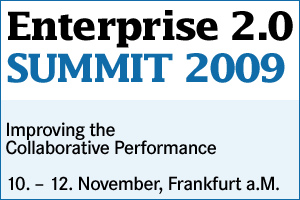So I planned the coming next two weeks, tomorrow I’m at an IBM Lotus Connections event, thursday is a day off when I will meet some friends of old (I am going to practice my Enterprise 2.0 evangelizing skills ;), and then beginning with Saturday 3rd of November five high-voltage days of Web 2.0 and Enterprise 2.0 conferences in Berlin are scheduled:

I have prepared a session for the BarCamp and will provide some details soon.

If you want to meet me in person – whether at the BarCamp Berlin or at Web 2.0 Expo, get in touch (directly or via crowdvine) – I would be happy to shake hands with you.
On Sunday evening I will be at the Berlin Geek Dinner, organized by Stowe Boyd, on Mondy evening at the Ignite event and nearby the coffee outlets during the conferences anyway.
Now to the tracks I am planning to attend, obviously the BarCamp and Web 2.0 Open tracks aren’t fixed yet, so let’s delve into Web 2.0 Expo, here’s the overview of the five tracks:
Web 2.0 Expo in Berlin will cover a wide variety of topics, organized into five tracks:
* Design and User Experience
* Development and Web Operations
* Fundamentals
* Marketing and Community
* Strategy and Business Models
These are my planned sessions (for an overview of all sessions see here):
Killing the Org Chart: Organizational, Cultural and Leadership Models on the Bleeding Edge
Tuesday, 6 November – 9:00 am–9:50 am
Self-organizing teams, transparency, and leaderless organizations have captured the imagination of the business community, but the paradigm of traditional hierarchy still dominates. What seems to hold us back are the huge unknowns of change: what happens when you restructure around these new principles? This session describes CoreMedia’s adventures in tossing out their organizational chart, redefining roles and teams, and decentralizing decision-making. They have defined personnel and technical management as discrete areas, and all staff members are assigned to one of the three Competence Centers. The directors of these centers give staff regular feedback, foster personal development, manage the career models and also oversee the assignment of staff to projects based on their specialist skills. Projects themselves are offered as “invitations to tender” and in regular “Waterhole meetings” any member of the staff can present an idea to work on. These are just a few examples of the structures of this self-organized company. They’ve made some bold moves and have real-world results to share with you. But one result upfront – creativity has boosted throughout the company. The second part of the session is an open discussion with attendees about what has worked in other organizations and the challenges and benefits of evolving and/or revolutionizing your organization. Attendees will receive the results of research on Enterprise 2.0 acceptance, challenges and tools in German companies.
This is my ideal start into the conference, I look forward to hearing the experiences of Sören Stamer and the CoreMedia team. Sören is a guy I would really love to meet.
Business Models for Web 2.0 Companies
Tuesday, 6 November – 10:10 am–11:00 am
Make traffic, not money – that seems to be the mantra of many Web 2.0 sites. Yet, as many VC-backed companies start to explore exit opportunities, successful execution of the business model is key. So how do you translate consumer adoption into hard dollars? Network effects are probably the single most important driver for the remarkable success of Web 2.0 properties…can these be used to fuel the revenue generation engine, and how? Are the low CPM troubles of social networks a sign that advertising is not the solution? And what kind of content do consumers actually pay for? Where are the trade-offs between the different models? These and other questions will be answered, along with a look at the current market situation and the future of monetization on the web.
Algorithmic Business Strategies – If everything’s being uploaded and shared, what might be next?
Tuesday, 6 November – 5:00 pm–5:50 pm
Google’s commercial success is based on the idea of identifying a variety of factors, from text analysis to human interest, and use them as variables in a giant mathematical equation that generates billions of revenue, widely known as AdSense. But how would a traditional corporation look like when it’d work like AdSense? Will we offshore intelligence to machines? What are the opportunities and threats? What happens when the whole world, from culture to politics become financial markets driven by algorithms? A joint state-of-the-art review of a new breed of businesses relying on mathematical models, potential scenarios how this approach will become mainstream and what this might mean to you and your business.
Looking forward to Dirk Baecker, but I am not sure whether I will dig this really. Hopfully not too fuzzy.
Web 2.0 Design Patterns, Models and Analysis
Wednesday, 7 November – 9:00 am–9:50 am
Many enterprises seek knowledge of the design patterns used by successful Web 2.0 companies. This session starts with Tim O’Reilly’s list of Web 2.0 examples and distills the abstract architectural patterns from behind the examples. By using the patterns notation, the core knowledge of the design principles is preserved in a template which can be reused in multiple contexts.
Duane will also show the evolution of the client server model into a 5-tier model based on the consistent concepts of most successful Web 2.0 patterns. The model serves as a useful starting point for anyone either designing business models or technology for Web 2.0. The Web 2.0 model is also used to illustrate a reference architecture. This abstract set of technology components allows developers to start thinking about the types of technology decisions required for building Web 2.0 projects.
Now this is interesting for its business model innovation implications, so I am deeply invested in this track.
Federated Social Networks
Wednesday, 7 November – 11:20 am–12:10 pm
Up till now, so-called Social Networking services have been built as walled gardens, where people can interact only within the confines of that service. As people’s preferences differ, they tend to be attracted to different services, roughly around the same kind of social objects, than some of there friends, family. To keep up with everyone, people tend to just sign up on several competing services. Then, for example for microblogging services like Jaiku, Twitter, etc., they need to post to all of them to keep everyone up-to-date. Let’s make Social Networks be social, too. This talk will go into federating different social networks using the protocol behind Jabber: XMPP. It will focus on sharing activity streams between services in near-real time using a number of XMPP extension protocols. For example, subscribing to someones Tweets from Jaiku and seeing updates appear in your overview or sent as a notification via IM as they happen. It will show you how to use these protocols to interact with other services.
OpenID: Emerging from Web 2.0
Wednesday, 7 November – 3:50 pm–4:40 pm
While OpenID is certainly gaining traction around the Web, many questions around security and privacy have been raised. Additionally with companies like Sun Microsystems shipping OpenID code, the question of how OpenID helps the enterprise becomes increasingly important. In under two years, OpenID has grown from a thriving grass-roots community to being supported by major companies, service providers, and open source projects.
This session will provide an introduction to OpenID, thoughts on how enterprises can benefit from integrating the technology, as well as a showcase of innovation around security technologies combined with OpenID such as smart cards, browser add-ons, and the like.
I’ve been examining OpenID lately, hence this session may provide some more evidence. Hopefully also good information on LDAP, SSO and the like for wiki integration into the corporate IT.
Copy vs. Create: Learning and Innovating in a Flat Web 2.0 World (The TechCrunch Follow-up)
Wednesday, 7 November – 5:00 pm–5:50 pm
As Web 2.0 is now a global phenomenon, its powerful concepts find their applications everywhere around the world. What primarily started as a trend among U.S. startups quickly spread to other continents where entrepreneurs recognized the potentials and were quicker than their role models to localize and launch similar companies. Whether you agree or disagree with this trend, it certainly can’t be ignored. So what are the lessons and what does localization mean in Web 2.0 terms? How do Web 2.0 applications differ internationally and where is there innovation? Using an extensive series of examples, this talk will cover what European, Asian and American companies have learned, invented and adjusted when making Web 2.0 a global/local phenomenon.
I would also love to go to these other sessions but I can’t – so if any of you my dear readers gets notice of any writeups, please let me know.
Moving from 1.0 to 2.0: Philosophies and Structures for Change
Tuesday, 6 November – 9:00 am–9:50 am
The 2.0 web world is more than just embedded technology – it is a philosophy. Companies who embrace this thinking are more flexible, agile, and innovative in their strategy and approach, but moving in this direction means rethinking structure, management style, workflow, and culture. How teams are structured, educated, and implemented in your organization is key. Are you a design firm, individual freelancer, or corporation trying to migrate past ‘old-school’ thinking and move yourself, management, or team into a more progressive era? Come hear how others have made innovation a priority – through carefully guided leadership and an environment that fosters creative thinking and collaboration.
Blogs, Social Networks and Podcasts: Corporate Communications 2.0
Tuesday, 6 November – 5:00 pm–5:50 pm
Today’s successful corporate communications and PR efforts are moving faster and faster towards the Web 2.0 channels of the day. Even some of the largest companies are using blogs, podcasts, videos – even Twitter and Jaiku – to reach customers, employees, and shareholders. Many of these efforts have had excellent results, others not so much. How does PR and corporate communications operate today, in a world full of direct communication with customers via web sites, email, blogs, and video?In order to use update your corporate communications plan, you need to consider corporate blogging practices that fit your company and situation, understand the variety of channel and tools available, and learn to blend the old with the new.Through a variety of corporate case studies, find out how businesses can use blogs and other forms of online communication to reach out and inform their customers, connect with their employees and their community, and create conversations and relationships that last.
This last session that I’ll have to miss is something I really miss:
Enterprise 2.0: Tools for Changing Organizations
Thursday, 8 November – 11:20 am–12:10 pm
The user experience is more critical today with the emergence of Web 2.0 during the past few years. Today wikis, blogs, and widgets are a part of the daily nomenclature in the work environment, but there are many questions around how this Web 2.0 world moves into the Enterprise world. How do software vendors bring the best features and functionalities to the masses? Are these companies spending their R&D on bringing to market small applications that focus on one task or are they focused on improving their core applications, or is both possible? Do Web 2.0 apps have enough speed, security, and stability for the Fortune 500 CIOs and thousands of employees around the world? This panel will explore the intersection of the Web and Enterprise 2.0 worlds and discuss what is ready for prime time.
I can’t be there, but hopefully Frank Hamm will cover this session … so I can catch up afterwards.







